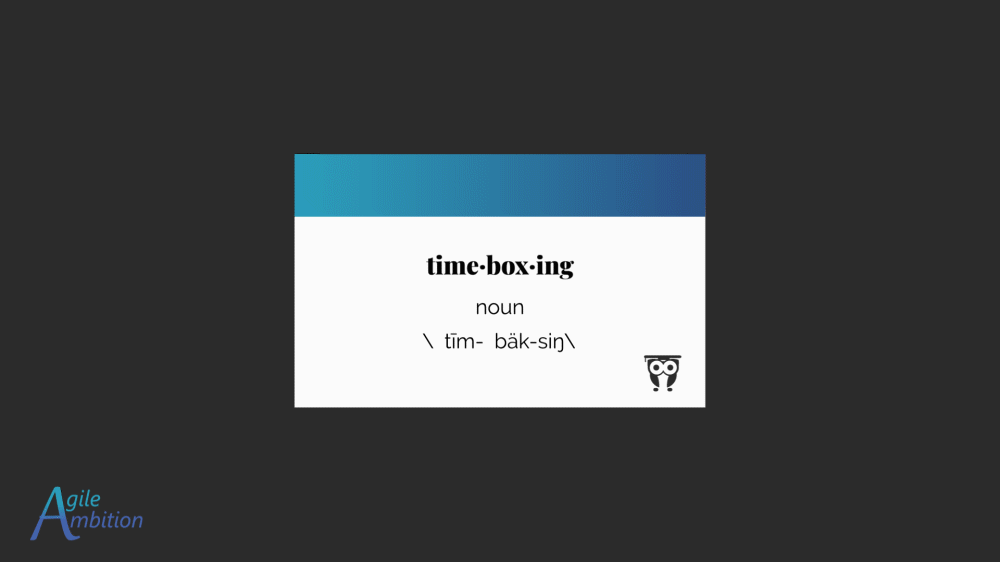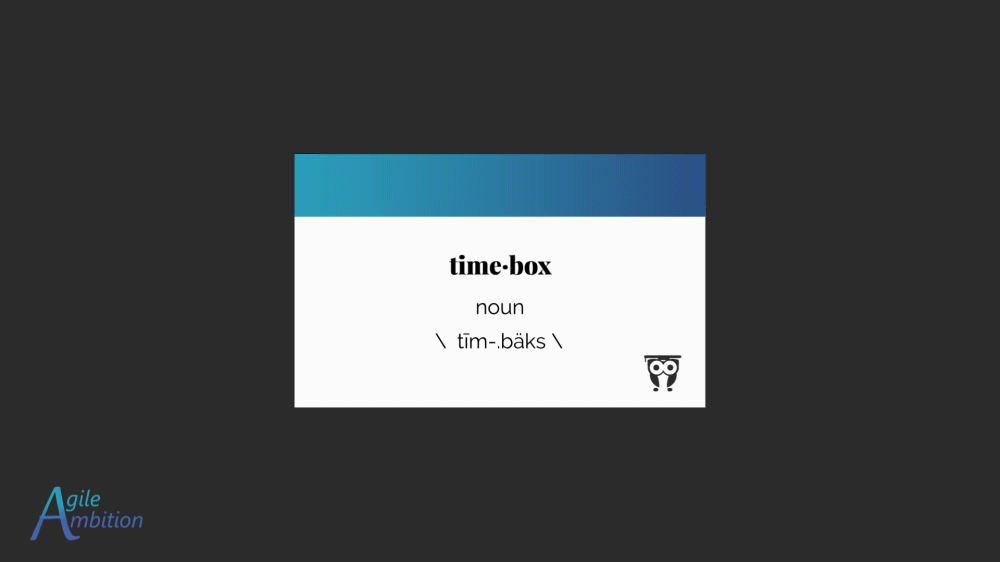Agile Timeboxing: The Secret Key to Velocity

The Sprint timebox provides the team with some advantages. Awareness of timeboxing benefits can help your team unlocks greater efficiency.
Defining Timeboxing
As with most things, I usually start with definitions when I’m trying for an in-depth understanding. Kenneth Rubin’s Essential Scrum is the best resource for this that I’ve found thus far. He covers both the benefits of timeboxing as well as the benefits of short durations. So for purposes of this vocabulary lesson, we’ll borrow his definitions.

Timeboxing is a time management technique that helps organize the performance of work and manage scope.
Okay, so that isn’t hugely helpful. Let’s take a look at timebox.

A timebox is a fixed-length period of time during which an activity is performed.
In essence, the act of timeboxing is about identifying one or more tasks we will complete in a fixed amount of time. For instance: I will write about ‘Agile Timeboxing’ for one hour. Before we dig into the benefits of timeboxing, let’s look at some examples to make the advantages more applicable.
Examples of Timeboxes
The most notable example of a timebox is the Sprint in Scrum or the Iteration if we want to use generic Agile terms. Two weeks is the most common fixed period used by the Scrum team. In this time frame, the team will focus on a defined scope of work (the Sprint Backlog). The goal is to get all the Product Backlog Items on the Sprint Backlog done before the end of the Sprint.
The Daily Scrum is also timeboxed. We’ll establish a plan for the day that gets us closer to meeting our Sprint Goal in no more than fifteen minutes.
In fact, All of the Sprint events are timeboxed. The Scrum team can decide how much time they need for each event, but once they set the length, the team should commit to staying within those guardrails. Each of the five Sprint events should have a fixed duration. It’s the Scrum Master’s role to enforce the timebox and help the team accomplish the goal of each event in the allotted time.

Spikes are also another example of timeboxing work. We have a problem to solve, but we need to perform research to determine the next steps. We might need to perform root cause analysis or run some proofs of concept. The ambiguity around these tasks makes them hard to estimate. Instead of sizing them, we allocate what we think is a reasonable about of time to the Product Backlog Item. When that time has passed, we evaluate the next steps. Do we need more time, help from the team, or is what we’ve learned enough to move on?
My morning routine is another example of a timebox. I start my workday with a list of ten tasks and give myself one hour to complete them. These days it’s rare that I make it to the end of my list, but once my hour has passed, I move on to something else. I won’t sacrifice my other daily commitments to continue indefinitely until I’ve finished all ten tasks.
Timebox vs Time Box vs Time - Box
If you’re playing scrabble and you see an opportunity to use this word, don’t bother. The dictionary doesn’t recognize it as a real word yet. This contributes to the question of the term’s proper spelling. Each resource I reference uses a different version of the spelling.
A google Ngram search shows that time box is the most popular, with timebox running a close second. I’m happy to see that time - box is the least used because I hate trying to ensure my fingers are in the correct place to type the hyphen.
Throughout the remainder of this article, I’ll continue to use the ‘timebox’ for two main reasons. First, it’s slightly faster to type (not having that extra space and all). Second, it’s the version used in the keyword I’m targeting for the article to help it appear in a google search.
Timeboxing Benefits
The benefits of timeboxing are not limited to agile teams. As we review each advantage, I’ll attempt to give a personal and agile-based example.
Laser Focus
Setting aside a dedicated block of time for a defined scope of work stimulates focus. I’ve found this to be true regardless of whether the commitment is personal or shared with a team.
I assign a time limit to each phase of my blog writing process. It’s become a bit of a game for me to try to be successful at this challenge. I will not let Facebook or Candy Crush come between me and my goal. Sometimes, I even imagine that I’m racing my archnemesis.
When I’m focused on writing, I might receive several interruptions during this time. Text messages, a knock on my office door, or thoughts about things that I need to remember to do later all assault me. I defer these interruptions to my next break. Very few things in life can’t wait a single hour before being addressed.
Before making this recent change, I would write for as long as it took. Often I’d go down rabbit holes of YouTube videos and click-bait articles. I fell victim to Parkinson’s law:
“Work expands so as to fill the time available for its completion”
Since I didn’t have time set aside expressly for completing this work, the work continued indefinitely, and I lacked a sense of urgency. After implementing a time constraint, I’ve seen a five-fold increase in my productivity.
Scrum teams that embrace the Sprint can also experience productivity boosts. The team rallies around the Sprint Goal. Their Daily Scrum focuses on planning the subsequent actions required to complete the goal and removing impediments. Scrum teams defer unplanned work to future Sprints. The team strives to complete the work of the Sprint Backlog by the end of the allocated timebox.
Avoid Waste
I sometimes fall prey to both analysis paralysis and gold plating. I have a natural tendency to analyze things past the point of effectiveness, and I’ll continue to spend time improving things that are good enough already. Timeboxing provides a means to avoid these wastes.
To combat these habits, I clearly define the scope of what I wish to accomplish in a time box. I take comfort in the fact that no one else will see my first draft in its raw state. The point isn’t to have a perfect post but rather to get my ideas down. Stephen King has referred to this as writing with the door closed.
“Write with the door closed, rewrite with the door open. Your stuff starts out being just for you, in other words, but then it goes out.”
―Stephen King
I don’t spend precious time in the first draft making my words perfect, as I’ll have a future timebox dedicated to that work. Since my final polish phase is also limited in time, I can’t continue to gold plate things indefinitely.
If the Scrum team is going to complete their Sprint Backlog on time, they need to ensure that they’re doing the minimum amount of work to accomplish the acceptance criteria and definition of done. Anything beyond that puts the Sprint Goal at risk.
I’m in no way implying that we cut corners or reduce quality. We do the work that the customer asked of us to the standards enforced by our DoD. Suppose we discover additional needed work that the team or customer didn’t account for in Sprint Planning. In that case, we can create a Product Backlog Item for that functionality and let the Product Owner prioritize it in a future Sprint.
A definition of ready can help the Scrum team avoid analysis paralysis. Assuming the story has the appropriate level of detail, and the team has discussed and estimated the story in Sprint Planning, there shouldn’t be enough ambiguity left to warrant analysis paralysis.
Enable Continuous Improvement
The utilization of fixed time periods allows you to evaluate your effectiveness. In Scrum, the goal is to complete the Sprint Backlog within the Sprint. If the team doesn’t hit their goal, they look for root causes in the Sprint Retrospective. This examination allows us to tweak processes, tools, and our definition of done, hopefully resulting in improved chances of hitting future Sprint Goals. Teams lacking either the fixed scope (Sprint Backlog) or the timebox lose this measuring stick.
I recently took time to map out my entire content publishing value stream. I assigned each step in the process a fixed timebox. Once the
Each step in my content development process has an associated fixed timebox. Sometimes I don’t complete the work in the time allowed. When this occurs, I evaluate the actions that led to this situation. Did I get distracted? Did going over my timebox in the first draft phase cause me to write more than I could edit in the time allowed for the second draft? Did the margaritas from yesterday reduce my ability to focus today? Once I determine the root cause, I tweak my process to avoid making the same mistake in the future.
The combination of fixed scope and timeboxing provides data points developers can use to evaluate and improve processes.
Instill Ownership
Something about the challenge of completing something in a fixed period of time makes me want to win. I’m committed to this idea and desire to accomplish my goal, which is like a rallying point.

Scrum teams should also rally around the Sprint Goal and be committed to doing everything within reason to hit the goal. Just because we’re at work doesn’t mean there can’t be some level of excitement around the challenge.
Realistic Scope
I tend to work on too many things at once. I think it’s a side effect of being in a Scrum Master role for multiple teams for so long. My mind is always occupied by trying to juggle multiple tasks at once. I suffer from a nagging sense of pending doom about everything on my to-do list.
Psychologists are now discovering that procrastination may be more about avoiding negative emotions. I think it was just the crushing feeling of knowing how much work was ahead of me.
The best way to eat an elephant is one bite at a time.

Timeboxes have let me focus on just one bite of the elephant at a time. As a result, I’ve nearly eliminated my procrastination (at least in the case of creating blog posts).
Learning the art of timeboxing allowed me to set everything aside for a short time. All the other items don’t matter, just the one thing I’ve chosen to focus on here and now. I’ve learned more about how much work I can realistically accomplish in any given period. If I want to meet the goals I’ve set for myself, I need to limit what I’m working on. It’s easy to recognize the impracticality of trying to write five blog posts in 30 minutes. But it’s harder to identify what I can realistically accomplish with a given chunk of time.

This same concept applies to Scrum teams, especially when they first implement Scrum. In the first Sprint, they tend to overestimate how much work they can get through. The more iterations they get under their belt, the better they’ll be at judging what is realistic.
“Selecting how much can be completed within a Sprint may be challenging. However, the more the Developers know about their past performance, their upcoming capacity, and their Definition of Done, the more confident they will be in their Sprint forecasts.”
And as they start taking more reasonable-sized bites out of the Product Backlog and focusing on completing the Sprint Backlog, they’ll grow more comfortable with the idea that they’re completing work incrementally. The knowledge that there are hundreds of things on the Product Backlog won’t be the devastating weight it was in the past.
Opportunity to Pivot
Another benefit of timeboxing is that it allows the team to pivot. Think of the Gantt charts of traditional project management. We have this big upfront design where, early in the project, we determine precisely how we’ll execute each step.
Any alteration typically needs to go through an arduous change management process where some prestigious people review and sign off on it. In cases where we need to be able to pivot quickly, this type of process can be crippling.

Planning in Sprints allows us to take a more agile approach. We may have a rough roadmap of where we want to be, but we don’t lock ourselves into a plan. Each iteration is a chance to apply newly learned information and select and execute the work that we believe will help us accomplish our goals.
In extreme cases, if we need to change our plan before the end of a Sprint, Scrum even allows the ability to cancel a Sprint and re-boot. Upon the cancellation of the Sprint, the entire team immediately goes into Sprint planning and resets the focus on this new priority.
Works Consulted
- Scrum Shortcuts Without Cutting Corners: Agile Tactics, Tools & Tips
- Essential Scrum: A Practical Guide to the Most Popular Agile Process
TLDR
There is something about a looming deadline that helps you get your priorities in perspective. It may be mostly psychology, but the fact remains that we cannot deny the myriad of benefits afforded to us by timeboxing. If you’d like to increase your team’s productivity, reduce waste, and seize opportunities to pivot, utilizing the Sprint timebox to its full potential is key.
Share
Table Of Contents
Buy Me a Coffee
Are you gaining value and insights from Agile Ambition? If you love what you're learning and want to see more, here's a simple way to show your support. Click the "Buy Me a Coffee" button to make a small donation. Each coffee you buy fuels our journey to discover better ways of working by unpuzzling Agile, one piece at a time.
Buy Me a CoffeeRelated Posts
Quick Links
Legal Stuff

